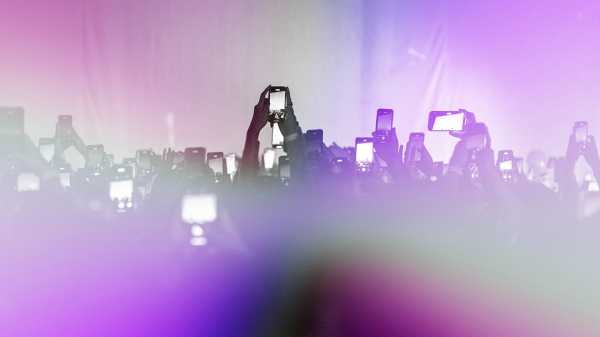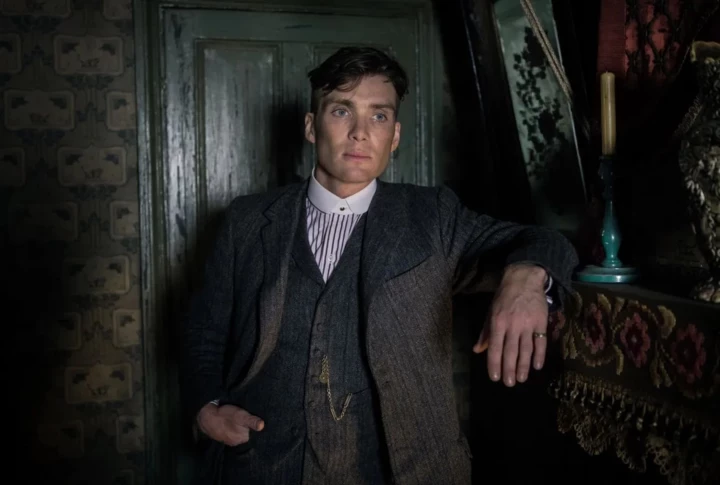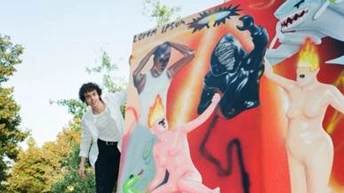
Save this storySave this storySave this storySave this story
If you attended the 2019 Venice Biennale, you might have waited in a long line to see the prize-winning piece “Sun & Sea (Marina),” an opera performance staged by three Lithuanian artists on a sandy faux beach that had been installed in a warehouse. A couple dozen performers acted out seaside leisure activities—sunbathing, digging, reading—and sang about the destruction of the environment by climate change as audience members peered down at them from a darkened balcony above. The work, which was visually arresting and hard to access directly, found a second life on social media, where posting a photo or video clip amounted to both a promulgation of the art work and a brag at having seen it. In a new book titled “Disordered Attention,” the British art historian Claire Bishop describes this mode of spectatorship as a “continual oscillation between watching and being online.” The viewer first gauges her own experience of the work, then takes a photo, then texts a group chat about it, then returns to looking. Later, she might check a hashtag to see what kinds of photos other people posted about the same piece.
Bishop’s book argues, refreshingly, that this might not be such a bad thing. “Deep attention continues to be seen not just as superior but as constitutive of our humanity,” she writes. We are supposed to stand alone in front of van Gogh’s “The Starry Night” and gaze at it, as opposed to snapping a photo and sharing it. We might even feel guilty for looking at our phones at all in the Museum of Modern Art. But, Bishop argues, our smartphone-induced state of distraction can also be generative. The art work, she writes, “is less self-important, less total; it grants us the space to be mobile and social, to react, chat, share, and archive as we watch.” These changes, in a way, represent a return to a pre-modern way of consuming culture through “sociable spectatorship.” By way of comparison, Bishop points out a change in the way theatres were historically designed. Before Wagner built his Bayreuth Festival Theatre, an opera house in Germany, in the late nineteenth century, audiences were arranged in a horseshoe ring, facing each other as well as the stage. Wagner decided to align the audience to face the stage directly, and, whereas, in the past, theatres had been well lit, he decided to plunge them into darkness. What was once a social experience became an individual encounter with art, in the modernist mode. Perhaps the smartphone has merely restored our ability to talk to one another about the aesthetic experience at hand and make it our own. We are all art curators now, exhibiting a selection of works on our feeds.
Not all artists want to see their work turned into shareable online content. Some, like the performance artist Tino Sehgal, reject this new model of engagement entirely by banning documentation of their work, maintaining the modernist ideal. Other artists have embraced what Bishop calls “viral attention” as a fundamental feature of their work. Bishop cites a performance by the Russian art collective Voina in which they painted an enormous penis on a bridge in St. Petersburg. Police prevented the group from finishing, but when the drawbridge was raised a few minutes later, “it faced the FSB building (the Federal Security Service, formerly the KGB) like a raised middle figure,” Bishop writes. The imagery travelled around the world; to Voina, the media phenomenon was part and parcel of the art work itself. By taking digital possession of the piece, its viewers had done it a service.
In another new book, “Black Meme,” the curator and author Legacy Russell, who now directs the venerable Manhattan experimental-art venue The Kitchen, is also interested in exploring how sharing images online affects the images’ creators and subjects, but she is far less sanguine about what she finds. The book takes stock of the ways in which Black creators and Black culture have provided many of the memes that travel most rapidly online. Russell traces this pattern all the way back to the Internet’s “first digital meme”: a diapered baby dancing a kind of cha-cha, with arms outstretched and hands twirling. The animation was created in 1996 when the co-founder of an animation company was developing new software. It was turned into a GIF, a compact file format that could easily be attached to e-mails—remember when virality happened by e-mail?—and spread so wildly that the baby eventually starred in an instantly famous episode of the television show “Ally McBeal.” Distribution makes a meme; the strongest meme is the one that spreads the widest, and the file was optimized for sharing. The dancing baby may now seem like distant history to Gen Z Internet users, but Russell revisits it as a harbinger of digital culture ever since. Although the baby’s skin tone in the animation was pale, the choreography and the name given to the figure—“Baby Cha-Cha”—were, Russell points out, clearly a reference to Afro-Cuban traditions. The dancing baby was “an imaginary projection of a Black child who dances for the viewer on loop, in endless labor.”
After reading those lines, it’s hard to go back to seeing the animation as innocent nineties-in-box fodder. “Memes are not neutral, nor are they passive subjects,” Russell writes. The book, more a polemic than a detailed history, includes in its analysis a series of largely pre-digital pieces of media that gained afterlives online. The dancing baby is a meme, but so, in Russell’s view, is a 1913 silent film, “Lime Kiln Field Day,” in which two Black performers kiss; and the photograph of Emmett Till’s corpse in a casket, published by Jet magazine in 1955; and Michael Jackson’s music video for “Thriller.” In each case, imagery echoes and rebounds in culture, getting adopted by visual artists, remade by fans, divorced from and then restored to its original context. These are not just memes but “Black memes,” which Russell defines as “the mediation, copying, and carrying of Blackness itself as a viral agent.” Black creativity has served as the font for a lot of what now falls under the umbrella label of “Internet culture,” from the riffing humor of “Black Twitter” to the “Renegade” dance, first created by a young Black woman named Jalaiah Harmon, but later popularized by the white influencer Charli D’Amelio on TikTok.
Bishop’s and Russell’s books converge on the idea that shareability ultimately cleaves a work of art, or a piece of media, from its creators. Distribution can magnify impact, and generate conversation, but it doesn’t necessarily deepen understanding. (On the contrary, we often share things long before we fully grasp what they mean simply to signify our participation in a public exchange.) The two authors reference Walter Benjamin and Hito Steyerl to describe how this form of decay—the loss of authorship and context—is an inherent consequence of the infinite reproduction of the Internet. Control is often traded for exposure. Russell argues that the authors of Internet culture are not compensated in the way that they should be, with credit and money: “Give Black memes their royalties,” she writes. If audiences are now co-creators of culture, through the online social experience of consuming it, then we must participate conscientiously, with an awareness of how sharing a work transforms it. Russell asks, “As a conductor, what are you transmitting? And are you listening?”
These are grand, abstract questions without easy solutions, in part because the structural problems of digital platforms shape the behavior of individual users. Still, “Black Meme” makes a persuasive case that provenance is central to understanding the long, convoluted lifespan of media fragments online. In one chapter, Russell documents the afterlife of Breonna Taylor, who was killed when police officers fired shots through her apartment in 2020. Russell describes how Taylor’s image became a symbol of activism in memes and hashtags, then gradually transformed into an aestheticized decoration, plastered on magazine covers and kitsch signs sold on Amazon. When any kind of imagery circulates as a meme, the original has a way of getting lost amid the profusion, becoming ubiquitous and invisible at the same time. ♦
Sourse: newyorker.com







